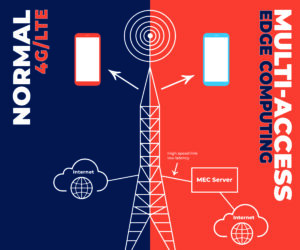What is 5G?
5G, short for Fifth Generation, is the next technical evolution of cellular-based technology. Roughly every ten years cellular technology takes a large leap forward, which is where we see a new “generation” (G). These leaps are carefully crafted with input from global standardization companies, cellular carriers, radio and antenna manufacturers, and phone vendors to ensure that while advancing technology, specifications allow for backward compatibility.
Multi-Access Edge Computing
5G has the ability to break from the traditional architecture where data goes from your phone to a tower, to a central processing location (Network Core), back to a tower, and finally back to your phone. Multi-Access Edge Computing (MEC) allows data to be “dropped off” locally at a tower, processed, and returned to your device. It eliminates the need for the data to make the long loop which is the current standard for data processing.
Shortening that loop reduces the time it takes for information to travel, be processed, and be shared back to you (latency). Examples of current applications leveraging MEC include Autonomous Vehicles and Augmented/Virtual Reality. Decreasing latency enables these types of applications to operate effectively. In both cases, long delays in communication and processing between devices may have adverse effects.
5G “Bands”
There are different frequencies, or bands, of cellular signals: low, mid, and high.
The “high” frequency is marketed as Millimeter (5G MM) or Ultra-Wide Band (5G UWB). This new frequency range did not exist before 5G. 5G MM/UWB allows for very high-speed data transfer but has a limited range. The lower the frequency, the slower the speed, but it is less hindered by obstacles (i.e. buildings in the way) and can reach further from the source. 5GMM/UWB is extremely fast but is significantly impacted by obstacles, leading to the need to be nearly line-of-sight between the phone/device and the source.
While exact speeds are impacted by a number of factors, 4G/5G/Sub-6 speeds often transmit 10s or 100s of MegaBytes per second (MBps)while 5GMM/UWB can transmit 1+ GigaBytes per second (GBps).
The Evolution of Cellular Capabilities and 5G
The first cellular phone was developed in 1973. Since then we’ve seen cellular capabilities develop rapidly. Increasing network speeds and supporting more customers and devices are two constant drivers of cellular improvements. Each generation also improved security, performance, coverage, and capacity. The current 4G/ 4G LTE generation brought increased speeds that allow customers to use Voice Over Internet Protocol (VoIP) phones and mobile hotspots. As we look forward, 5G and Sub-6 offer new technologies and provide even better speeds that will change how we use cellular wireless networks and will increase the art of the possible.
Choosing Your Wireless Technology
Cellular vs Wi-Fi
Wi-Fi
- Operates on unlicensed frequencies that are free to operators (2.4 GHz, 5 GHz and 6 GHz).
- Devices with 802.11 certified cards should work with the network.
- Networks can require either no authentication or require a full username and password to connect.
- Typically will cover a single living area (such as a single-family home).
- Can be configured per provider specifications.
Cellular
- Operates on licensed frequencies that are sold to operators (Verizon, AT&T, T-Mobile, etc.).
- Requires a vendor’s device (Vendor devices work within the Vendor’s network).
- Does not require user authentication.
- Typically will cover multiple neighborhoods.
- Limited configuration options.
Wireless Connectivity at Illinois
Our primary objective is to provide a seamless, best-possible network experience for customers. You should not have to know or understand how networking works for your device to have connectivity.
IllinoisNet
IllinoisNet is the primary Wi-Fi network owned and managed by Technology Services. It is designed to provide secure Wi-Fi access to users in all academic, instructional, and common spaces in buildings at the University of Illinois Urbana-Champaign. We are constantly expanding and upgrading the Wi-Fi service to provide a good experience. We have full control of IllinoisNet which is very robust and provides trusted, secure access to network resources. While on campus, we recommend that customers connect to IllinoisNet.
Cellular Service
We work with various cellular-based network operators to enhance cellular service across campus. IllinoisNet might not be the best fit for you, for example, if you’re doing your work off-campus where Wi-Fi is not available. In this case, cellular service might be a better fit. Cellular connectivity is often available in locations where Wi-Fi is not.
Technology Services works closely with both Wi-Fi and cellular technologies and with many groups on campus to help address their needs. Please consider reaching out to Technology Services so we can assist you in determining the best technology for your needs.
Get Help
Please contact the Technology Services Help Desk at consult@illinois.edu, 217-244-7000, or via request at help.illinois.edu if we can assist you in determining your best networking options.
